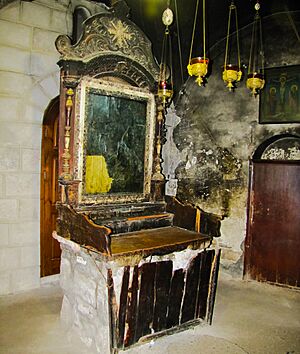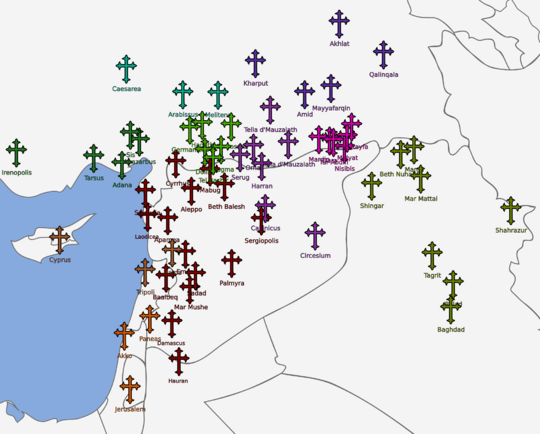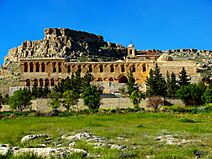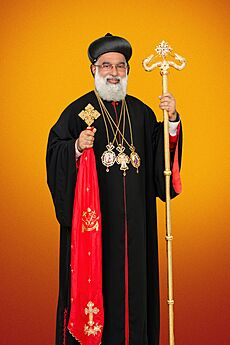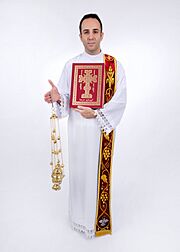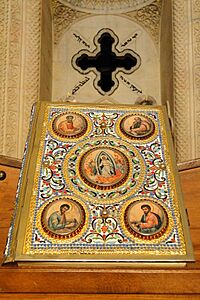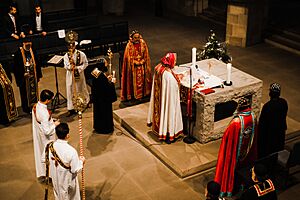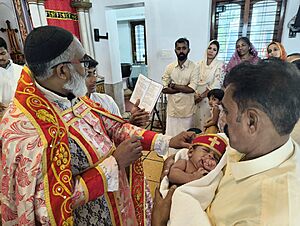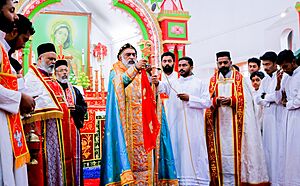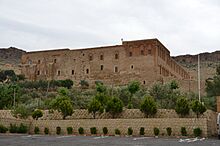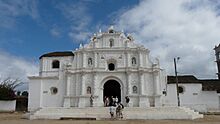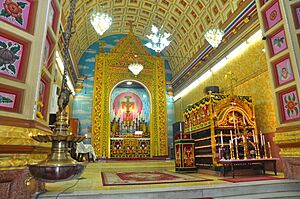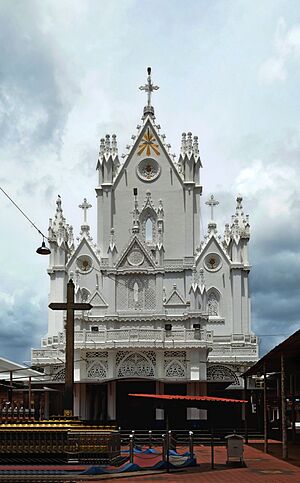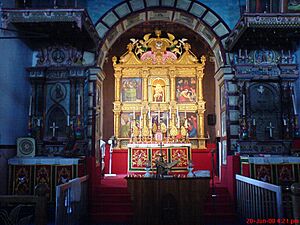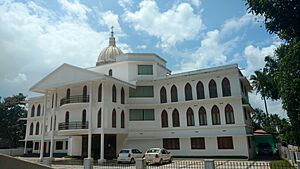Syriac Orthodox Church facts for kids
Quick facts for kids Syriac Orthodox Church |
|
|---|---|
| ܥܺܕܬܳܐ ܣܽܘ̣ܪܝܳܝܬܳܐ ܗܰܝܡܳܢܽܘܬܳܐ ܬܪܺܝܨܰܬ ܫܽܘ̣ܒ̣ܚܳܐ (Classical Syriac) | |
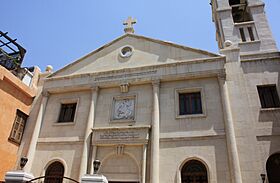
Cathedral of Saint George, Damascus, Syria
|
|
| Type | Autocephaly |
| Classification | Christian |
| Orientation |
|
| Scripture | Peshitta |
| Theology | Oriental Orthodox theology |
| Polity | Episcopal |
| Structure | Communion |
| Patriarch | Ignatius Aphrem II |
| Region | Middle East, India, and diaspora |
| Language | Classical Syriac |
| Liturgy | West Syriac: Liturgy of Saint James |
| Headquarters | Cathedral of St. George, Damascus, Syria (since 1959) |
| Founder | Apostles Peter and Paul |
| Origin | 1st century Antioch, Roman Empire |
| Independence | 512 |
| Branched from | Church of Antioch |
| Members | Approximately 1.5 million (including 1.2 million members of the Syriac Orthodox in India) |
| Aid organization | EPDC St. Ephrem Patriarchal Development Committee |
| Other name(s) | Arabic: الكنيسة السريانية الأرثوذكسية Malayalam: സുറിയാനി ഓർത്തഡോക്സ് സഭ, romanized: Suriyāni ōrtḥdōx Sabḥa Spanish: Iglesia católica apostólica siro-ortodoxa de Antioquía |
| *Origin is according to Sacred tradition. West Syriac Cross Unicode (U+2670) : ♰ |
|
The Syriac Orthodox Church is an ancient Christian church. It started in Antioch, a city in the Roman Empire, and is sometimes called the Jacobite Church. This church is part of the Oriental Orthodox Churches, which are Christian groups that have a slightly different understanding of Jesus Christ's nature compared to other major Christian churches.
The church has about 1.5 million followers around the world. Its main language for worship is Classical Syriac, which is a very old language. The leader of the Syriac Orthodox Church is called the Patriarch of Antioch. This leader is believed to continue the role of Saint Peter, one of Jesus's first followers. Since 2014, Ignatius Aphrem II has been the Patriarch.
The church's main office used to be in different places, including the Mor Hananyo Monastery for many centuries. But since 1959, its headquarters have been in the Cathedral of Saint George in Damascus, Syria. The Syriac Orthodox Church became a separate church in 512 AD. This happened after a disagreement about the Council of Chalcedon, a big meeting where Christian leaders discussed beliefs about Jesus.
Contents
Church Name and Identity
The Syriac Orthodox Church has been known by different names over time. People who speak Syriac have called themselves "Sūryoyē" based on their background. In many languages, a special name helps tell the church apart from the country of Syria.
In Arabic, the church is known as "Kenissa Suryaniya" because "Suryani" refers to the Syriac language and people. Some people called the church "Jacobite" after a bishop named Jacob Baradaeus. This name came about after a split in the church around 451 AD.
The word "Orthodox" means "correct belief." It was used to describe churches that followed the original teachings of early Christians. In 2000, the church officially decided to use "Syriac Orthodox Church" in English. This was to highlight its connection to the Syriac language and to avoid confusion with the country of Syria.
Even though the church welcomes people from all backgrounds, its main group of followers often identify as Assyrian or Aramean.
History of the Church
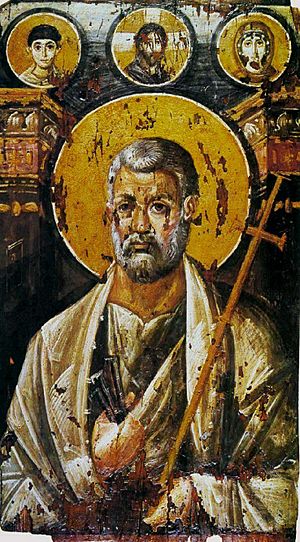
Early Beginnings
The Syriac Orthodox Church believes its roots go back to the very first Christian communities. These communities were started by Saint Barnabas and Saint Paul in Antioch. The Bible says that Jesus's followers were first called Christians in Antioch. Saint Peter is honored as the first bishop of Antioch around 37 AD.
The city of Antioch was very important for trade in the eastern Roman Empire. Because of this, an early church meeting in Nicaea recognized the Bishop of Antioch as a major leader in Christianity. This led to the creation of the "Patriarchate of Antioch and All of the East."
Later, there were disagreements about how to understand Jesus's nature. This led to a long struggle for leadership in Antioch. In 512 AD, Severus of Antioch, a leader who had different views, was chosen as patriarch. However, in 518 AD, he was forced to leave Antioch. Those who supported Severus continued to follow him and his successors, forming the independent Syriac Orthodox Church.
A bishop named Jacob Baradaeus helped strengthen this church in the 6th century. He ordained many leaders for the church during a time of difficulty. Because of his efforts, the church became known as the 'Jacobite' Church.
Middle Ages
During the Middle Ages, the Syriac Orthodox Church grew in certain areas. From 950 to 1020, Syriac Orthodox communities in places like Cappadocia and Syria experienced a time of growth. They even had access to important positions in the empire.
However, conflicts with other churches and later, the Mongols, caused difficulties. The church's main office had to move several times. In 1293, it moved to the Mor Hananyo Monastery near Mardin, where it stayed for many centuries until 1933.
Recent History
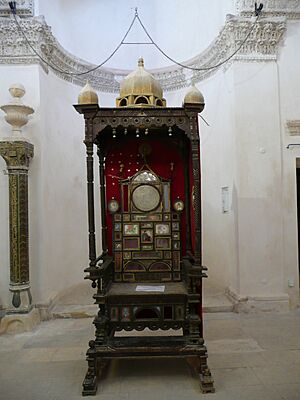
In the 1600s, many Syriac Orthodox people in Aleppo converted to Catholicism. This led to the creation of the Syriac Catholic Church. Around the same time, many Christians in Kerala, India, joined the Syriac Orthodox Church, forming the Malankara Syrian Church.
In the 19th century, the Syriac Orthodox Church gained independent status within the Ottoman Empire. This meant they could manage their own affairs more freely. Around this time, Syriac Orthodox communities began to move to other parts of the world, creating a Syriac diaspora. The first Syriac Orthodox church in the United States was built in Worcester, Massachusetts.
Between 1915 and 1916, many Syriac Orthodox Christians faced great hardship and violence in the Ottoman Empire. Many were killed, and their properties were taken. This period is known as Sayfo.
After these difficult times, in 1924, the church's patriarchate moved to Homs and then to Damascus in 1959. In the early 1920s, the city of Qamishli was built mostly by Syriac Orthodox people seeking safety.
In 2000, the church officially started using "Syriac" in its English name. This was to show its connection to the Syriac language and to avoid confusion with the country of Syria.
During the Syrian Civil War, which began in 2011, Christians in Syria faced many challenges. Churches were damaged, and some leaders were kidnapped. The church has worked to support its members during these difficult times.
Church Leadership
The Patriarch
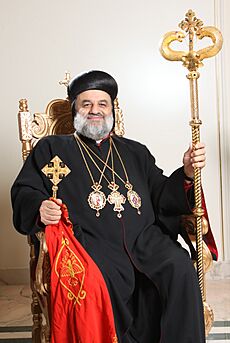
The highest leader of the Syriac Orthodox Church is the Patriarch of Antioch. He is considered the "father of fathers" and is in charge of the church's spiritual, administrative, and financial matters. He also handles the church's relationships with other churches.
Maphrian or Catholicos of India
The maphrian or Catholicos of India is the second highest leader in the church. This leader is based in India and guides the Jacobite Syrian Christian Church. The maphrian also plays an important role when a new patriarch needs to be chosen.
Archbishops and Bishops
A bishop is a spiritual leader who oversees a region. In the Syriac Orthodox Church, there are metropolitan bishops (also called archbishops) who lead larger areas called archdioceses. They are under the patriarch's authority.
Priests and Corepiscopi
A priest is a leader who performs the church's sacred ceremonies, called sacraments. Unlike in some other churches, Syriac Orthodox deacons can marry before they become priests.
Corepiscopi are priests who have been given a special honorary rank. They are seen as "first among the priests."
Deacons
Deacons help the priests during church services. There are different levels of deacons, each with specific duties. For example, a "full deacon" can carry the censer (a container for burning incense) during the main service.
Deaconess
A deaconess is an ordained woman who helps the priest and deacon outside the altar. She can enter the sanctuary for cleaning and lighting lamps. She can also give Holy Communion to women and young children.
Worship and Beliefs
The Bible
The Syriac Orthodox Church uses the Peshitta as its Bible. The New Testament part of this Bible was translated into Syriac between the late first and early third centuries AD. The Old Testament was translated from Hebrew, likely in the second century.
Church Teachings
The Syriac Orthodox Church follows the Nicene Creed, a statement of Christian belief. They believe they are the true church founded by Jesus Christ. They see their leaders as successors of Christ's apostles, and the patriarch as the successor to Saint Peter.
The church accepts the first three major church councils: Nicaea (325 AD), Constantinople (381 AD), and Ephesus (431 AD). These councils helped shape early Christian beliefs.
The Syriac Orthodox Church is part of Oriental Orthodoxy. This group of churches believes that Jesus Christ has "One Nature—the Logos Incarnate, of the full humanity and full divinity." They honor the Virgin Mary as Theotokos, meaning "Bearer of God."
Language in Worship
- Syriac: This is the main language used for worship and religious writings.
- Arabic: Many Syriac Orthodox clergy started writing in Arabic in the 15th century.
- English: Used globally alongside Syriac.
- Other Languages: In India, Malayalam, Tamil, and Kannada are used. In Guatemala, Spanish and some Mayan languages are used. In Europe, languages like Swedish, German, and Dutch are used.
Liturgy and Music
The main church service is called Holy Qurobo, which means "Eucharist" in Syriac. The Liturgy of Saint James is celebrated on Sundays and special days. This service includes reading from the Gospel, other Bible readings, prayers, and hymns. Many of the prayers are sung as chants and melodies. Hundreds of these melodies are kept in a book called Beth Gazo.
Daily Prayer
Syriac Orthodox clergy and followers pray seven times a day. These fixed prayer times are based on Psalm 119 in the Bible. The church day starts at sunset.
Sacraments
The Syriac Orthodox Church has seven sacraments, which are special holy ceremonies:
- Chrismation (Anointing with Holy Muron)
- Baptism
- Confession
- Holy Communion
- Marriage
- Anointing of the Sick
- Ordination
Vestments
Clergy in the Syriac Orthodox Church wear special clothes called vestments during services. These clothes are different depending on their rank. For example, a priest wears a black robe, a stole, a girdle, and a cope. Bishops wear a special turban and carry a crosier, which is a staff shaped like a shepherd's crook.
Where Syriac Orthodox Christians Live
The church's main office started in Antioch but moved several times due to challenges. It has been in Damascus, Syria, since 1959. Many Syriac Orthodox Christians have also moved from the Middle East to other parts of the world. They live in places like Sweden, Germany, the United Kingdom, the United States, Canada, and Australia.
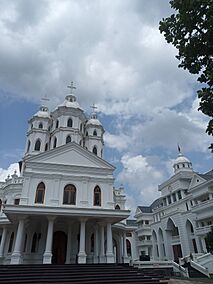
It's estimated that the church has about 600,000 Syriac followers, plus another 483,000 members of the Jacobite Syrian Christian Church in India. There is also a large community of Mayan converts in Guatemala and South America, numbering up to 500,000.
Church Regions and Leadership
The Syriac Orthodox Church has many archdioceses and special areas called patriarchal vicariates around the world. These cover six continents.
Americas
Syriac Orthodox Christians have lived in the Americas since the late 1800s.
North America
In North America, there are different areas for the church. The Patriarchal Vicariate for the U.S. and Canada was created in 1952. In 1993, a special archdiocese was formed for Indian followers living in North America.
| Region | Diocese or Vicariate | Metropolitan |
|---|---|---|
| United States | Patriarchal Vicariate of Eastern United States | Dionysius Jean Kawak |
| Patriarchal Vicariate of Western United States | Clemis Eugene Kaplan | |
| Canada | Patriarchal Vicariate of Canada | Athanasius Elia Bahi |
| United States and Canada | Malankara Archdiocese of North America | Titus Yeldho |
Central America
In Guatemala, a large group of people, mostly Mayan, joined the Syriac Orthodox Church in 2013. This area is known as the Archdiocese of Central America, the Caribbean Islands and Venezuela.
South America
| Region | Vicariate | Metropolitan |
|---|---|---|
| Argentina | Patriarchal Vicariate of Argentina | Chrysostomos John Ghassali |
| Brazil | Patriarchal Vicariate of Brazil | Severius Malke Mourad |
Middle East
The Syriac Orthodox Church has a long history in the Middle East. Its followers live in Syria, Iraq, and Turkey. They speak Aramaic and have many monasteries in the region.
| Region | Diocese or Vicariate | Metropolitan |
|---|---|---|
| Iraq | Archdiocese of Baghdad and Basra | Severius Hawa |
| Archdiocese of Mar Matta | Timotheos Mousa A. Shamani | |
| Archdiocese of Mosul and Environs | Nicodemus Daoud Sharaf | |
| Jerusalem and Jordan | Patriarchal Vicariate of Jerusalem and Jordan | Raban Gabriel Dahho |
| Lebanon | Archdiocese of Beirut | Clemis Daniel Malak Kourieh |
| Archdiocese of Mount Lebanon | Theophilus Georges Saliba | |
| Patriarchal Vicariate of Zahle | Justinos Boulos Safar | |
| Syria | Archdiocese of Aleppo | Gregorios Yohanna Ibrahim |
| Archdiocese of Homs & Hama | Timotheos Matta Al-Khoury | |
| Archdiocese of Jazireh & Euphrates | Maurice Amish | |
| Turkey | Patriarchal Vicariate of Istanbul & Ankara | Filüksinos Yusuf Çetin |
| Archdiocese of Mardin | Filüksinos Saliba Özmen | |
| Archdiocese of Turabdin | Timotheus Samuel Aktaş | |
| Patriarchal Vicariate of Adiyaman | Gregorius Melki Ürek | |
| Arabian Gulf and Emirates | Patriarchal Vicariate of Arabian Gulf | Barthelmaus Nathanael Youssef |
India
Jacobite Syrian Christian Church
The Jacobite Syrian Christian Church in India is a very important part of the Syriac Orthodox Church. The Patriarch of Antioch is its supreme head. The local leader in India is Baselios Joseph I, who was ordained in March 2025. The church's main office in India is in Puthencruz, Kerala.
Historically, Christians in India received leaders from different places until they fully joined the Syriac Orthodox Church in 1652.
Knanaya Archdiocese
The Knanaya Archdiocese is a special area for the Knanaya community in Kerala. They have their own archdiocese because they follow strict traditions about marrying only within their group.
Evangelistic Association of the East
The Evangelistic Association Of The East (E.A.E Arch Diocese) is a missionary group of the Syriac Orthodox Church. It was founded in 1924 and works to spread the church's message. It also runs schools, orphanages, and other helpful programs.
Europe
Many Syriac Orthodox Christians moved to Western Europe in the 20th century for economic and political reasons. They settled in countries like the Netherlands, Germany, and Sweden. The first Syriac Orthodox monastery in Europe was established in the Netherlands in 1981.
| Region | Diocese or Vicariate | Metropolitan |
|---|---|---|
| Belgium | Patriarchal Vicariate of Belgium, France and Luxembourg | George Kourieh |
| Germany | Patriarchal Vicariate of Germany | Philoxenus Mattias Nayis |
| Ecumenical Movement in Germany | Julius Hanna Aydın | |
| Netherlands | Patriarchal Vicariate of the Netherlands | Polycarpus Augin (Eugene) Aydın |
| Spain | Patriarchal Vicariate of Spain | Nicolaos Matti Abd Alahad |
| Sweden | Archbishopric of Sweden and Scandinavia | Yuhanon Lahdo |
| Patriarchal Vicariate of Sweden | Dioskoros Benyamen Atas | |
| Switzerland | Patriarchal Vicariate of Switzerland and Austria | Dionysius Isa Gürbüz |
| United Kingdom | Patriarchal Vicariate of United Kingdom | Athanasius Toma Dawod |
Oceania
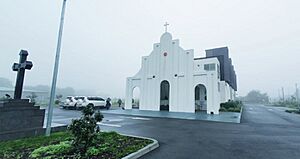
The Patriarchal Vicariate of Australia and New Zealand was founded under the patriarch's authority. It is led by Archbishop Malatius Malki Malki and is based in the Saint Ephraim Syrian Orthodox Church.
Church Institutions
The church has many schools, colleges, and other organizations. St. Aphrem's Clerical School was started in 1934 to train future church leaders. The Antioch Syrian University was opened in 2018 near Damascus, offering courses in engineering, management, and economics. The Happy Child House project, started in 2022, provides childcare services in Damascus.
Working with Other Churches
The Syriac Orthodox Church actively talks with other Christian churches, including the Catholic Church and Eastern Orthodox Churches. They are a member of the World Council of Churches and the Middle East Council of Churches.
In 1984, Patriarch Ignatius Zakka I Iwas and Pope John Paul II made a joint statement. They said that the old disagreements between their churches were mostly due to different words and cultures, not real differences in faith. In 2015, Pope Francis called the Syriac Orthodox Church "a Church of Martyrs."


